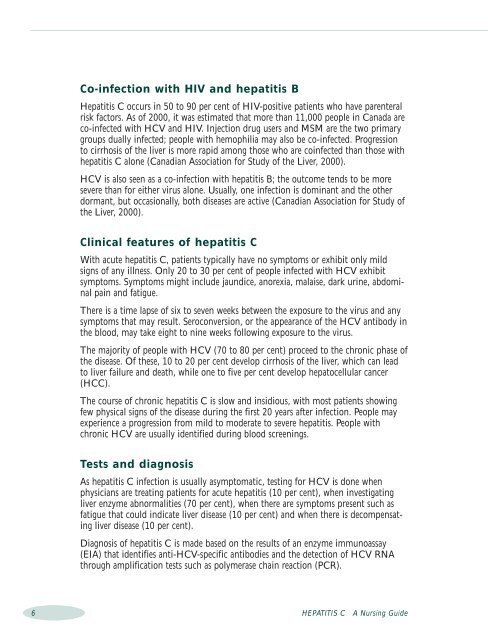Hep C - 2002.qxd - Canadian Public Health Association
Hep C - 2002.qxd - Canadian Public Health Association
Hep C - 2002.qxd - Canadian Public Health Association
Create successful ePaper yourself
Turn your PDF publications into a flip-book with our unique Google optimized e-Paper software.
Co-infection with HIV and hepatitis B<strong>Hep</strong>atitis C occurs in 50 to 90 per cent of HIV-positive patients who have parenteralrisk factors. As of 2000, it was estimated that more than 11,000 people in Canada areco-infected with HCV and HIV. Injection drug users and MSM are the two primarygroups dually infected; people with hemophilia may also be co-infected. Progressionto cirrhosis of the liver is more rapid among those who are coinfected than those withhepatitis C alone (<strong>Canadian</strong> <strong>Association</strong> for Study of the Liver, 2000).HCV is also seen as a co-infection with hepatitis B; the outcome tends to be moresevere than for either virus alone. Usually, one infection is dominant and the otherdormant, but occasionally, both diseases are active (<strong>Canadian</strong> <strong>Association</strong> for Study ofthe Liver, 2000).Clinical features of hepatitis CWith acute hepatitis C, patients typically have no symptoms or exhibit only mildsigns of any illness. Only 20 to 30 per cent of people infected with HCV exhibitsymptoms. Symptoms might include jaundice, anorexia, malaise, dark urine, abdominalpain and fatigue.There is a time lapse of six to seven weeks between the exposure to the virus and anysymptoms that may result. Seroconversion, or the appearance of the HCV antibody inthe blood, may take eight to nine weeks following exposure to the virus.The majority of people with HCV (70 to 80 per cent) proceed to the chronic phase ofthe disease. Of these, 10 to 20 per cent develop cirrhosis of the liver, which can leadto liver failure and death, while one to five per cent develop hepatocellular cancer(HCC).The course of chronic hepatitis C is slow and insidious, with most patients showingfew physical signs of the disease during the first 20 years after infection. People mayexperience a progression from mild to moderate to severe hepatitis. People withchronic HCV are usually identified during blood screenings.Tests and diagnosisAs hepatitis C infection is usually asymptomatic, testing for HCV is done whenphysicians are treating patients for acute hepatitis (10 per cent), when investigatingliver enzyme abnormalities (70 per cent), when there are symptoms present such asfatigue that could indicate liver disease (10 per cent) and when there is decompensatingliver disease (10 per cent).Diagnosis of hepatitis C is made based on the results of an enzyme immunoassay(EIA) that identifies anti-HCV-specific antibodies and the detection of HCV RNAthrough amplification tests such as polymerase chain reaction (PCR).6 HEPATITIS C A Nursing Guide
















